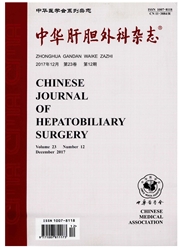

 中文摘要:
中文摘要:
目的了解CCRl趋化因子受体在人肝癌组织中表达分布情况,探讨其表达水平与临床病理特性的关系。方法采用RT-PCR、免疫组化、Western blot技术检测45例肝癌组织及相应癌旁肝组织CCRl趋化因子受体表达及分布情况,并分析其表达水平与临床病理特性的关系。结果RT-PCR、Western blot在肝癌组织及相应癌旁肝组织中均可以检测到CCR1趋化因子受体mRNA及蛋白,肝癌组织表达水平高于癌旁肝组织。免疫组化显示CCR1趋化因子受体主要表达于肝癌细胞膜。CCR1mRNA表达水平与病人性别、年龄、血清AFP水平、肿瘤大小、分期无明显相关性,而与肿瘤是否有包膜(t=2.305,P〈0.05)、门静脉浸润显著相关(t=3.004,P〈0.01)。无门静脉浸润的肝癌组织中,47.4%免疫组化染色强度为++~+++,而有门静脉浸润的肝癌组织中,80.8%染色强度为++~+++,两者比较差异具有显著意义(X^2=5.511,P〈0.05)。结论肝癌细胞表达CCR1趋化因子受体,其表达水平与肝癌侵袭性尤其是门静脉浸润相关,有望成为判断肝癌侵袭性及预后的指标。
 英文摘要:
英文摘要:
Objective To investigate the expression and significance of CCR1 chemokine recep tor in human hepatocellular carcinoma (HCC). Methods RT-PCR, immunohistochemistry and Western blot were used to determine the expression and distribution of CCR1 in HCC and adjacent liver tissues of 45 patients. The correlation between the CCR1 expression and clinicopathological features was statistically analyzed. Results CAER1 mRNA and protein could be detected in HCC and adjacent tissues. The expression level of CCR1 was up-regulated in HCC tissue as compared with adjacent liver tissue. Immunohistochemistry revealed that CCR1 protein was mainly located on the membrane of HCC cells. The expression of CCR1 mRNA in HCC was significantly correlated with absence of tumor capsule (P〈0.05) and portal vein invasion (P〈0.01) but not gender, age, serum AFP, tumor size and TNM staging. The moderate to strong staining of CCR1 protein was found in 80. 8% of HCC specimens with portal vein invasion, which was markedly higher than that in HCC without portal vein invasion (P〈20.05). Conclusions HCC expresses CCR1 chemokine receptor. The expression level of CCR1 is correlated with HCC invasiveness. Therefore, CCR1 may serve as a potential marker to evaluate the invasive ability and progress of HCC.
 同期刊论文项目
同期刊论文项目
 同项目期刊论文
同项目期刊论文
 期刊信息
期刊信息
